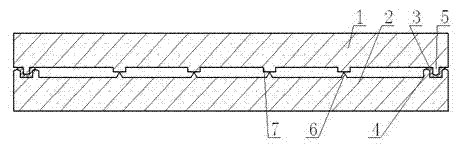Vacuum ceramic thermal baffle and manufacturing method of vacuum ceramic thermal baffle
A technology of vacuum ceramics and heat insulation boards, which is applied in the direction of climate change adaptation, insulation improvement, building components, etc., can solve the problems of poor heat resistance, water absorption, secondary fire, etc., to shorten the heating time, simplify the process, improve The effect of production efficiency
- Summary
- Abstract
- Description
- Claims
- Application Information
AI Technical Summary
Problems solved by technology
Method used
Image
Examples
Embodiment 1
[0068] Embodiment 1: see figure 1 , the two insulation boards of the vacuum insulation board are commercially available ceramic boards, one of which is a heat insulation board coated with a low-e film, and there are edge banding strips on the two heat insulation boards. The production method is as follows: Firstly, after cleaning and drying the ceramic insulation boards, the low-temperature glass powder paste is printed on the two heat insulation boards to make edge banding frames by printing technology. The heat plate has three edge banding frames, the size of the edge banding frame of the upper heat shield is between the two edge bands of the lower heat shield, after the upper and lower heat shields are combined, the edge band of the upper heat shield The frame can be fitted between the two edge banding frames of the lower heat insulation board. Under the action of high temperature, the edge banding frame is softened and melted and bonded with the ceramic plate, and then th...
Embodiment 2
[0071] Example 2: see figure 2 , The vacuum heat insulation board is composed of an upper ceramic heat insulation board and a lower ceramic heat insulation board, and the two heat insulation boards are surrounded by edge sealing strips. The production method is as follows: First, according to the shape and size of the vacuum insulation panel to be produced, metal stamping dies for the upper and lower insulation panels are prepared respectively. The surface of the mold has grooves to form the edge banding frame and support on the insulation panel. The upper heat shield has one edge banding frame, the lower heat shield has two edge banding frames and supports, and the size of the upper heat shield edge banding frame is between the two edge banding bars of the lower heat shield Between the frames, after the upper and lower heat insulation boards are combined, the edge sealing frame of the upper heat insulation board can be fitted between the two edge sealing frames of the lower ...
Embodiment 3
[0073] Embodiment 3: see figure 2 , the vacuum insulation panel is composed of an upper ceramic insulation panel and a lower ceramic insulation panel, one of which is a low-emissivity ceramic insulation panel coated with aluminum film, and there are edge bands around the two insulation panels. The periphery of the heat shield is welded together by low-temperature glass solder, and the middle is a vacuum layer. The production method is as follows: First, according to the shape and size of the vacuum insulation panel to be produced, metal stamping dies for the upper and lower insulation panels are prepared respectively. The surface of the mold has grooves to form the edge banding frame and support on the insulation panel. The upper insulation board has one edge-seal frame, the lower insulation board has two edge-seal frames, and the size of the upper insulation board’s edge-seal frame is between the two edge-seal frames of the lower insulation board , after the upper and lower...
PUM
| Property | Measurement | Unit |
|---|---|---|
| melting point | aaaaa | aaaaa |
| melting point | aaaaa | aaaaa |
| diameter | aaaaa | aaaaa |
Abstract
Description
Claims
Application Information
 Login to View More
Login to View More - R&D
- Intellectual Property
- Life Sciences
- Materials
- Tech Scout
- Unparalleled Data Quality
- Higher Quality Content
- 60% Fewer Hallucinations
Browse by: Latest US Patents, China's latest patents, Technical Efficacy Thesaurus, Application Domain, Technology Topic, Popular Technical Reports.
© 2025 PatSnap. All rights reserved.Legal|Privacy policy|Modern Slavery Act Transparency Statement|Sitemap|About US| Contact US: help@patsnap.com



